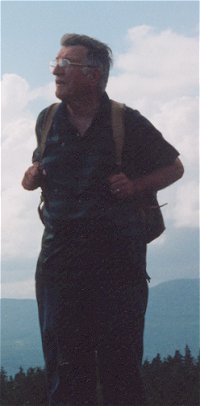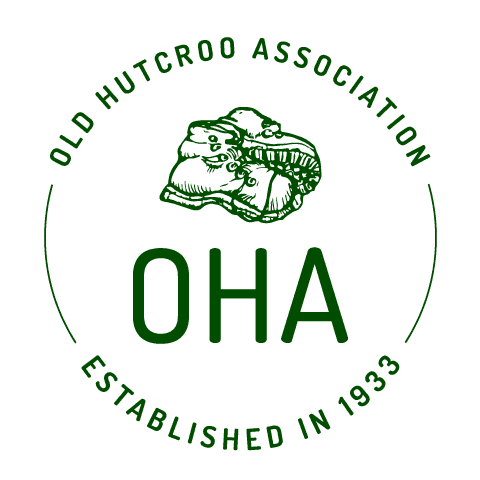Casey Hodgdon died June 15, 2002. He is survived by his wife Julia, a son, Travis, and a daughter, Trisha Ouellette. He had two brothers, both ex-hutmen, Earl and John.
Guy Gosselin wrote the following eulogy:
 “As the poet said, there are two mighty voices; one is of the sea, one of the mountains. Both of those voices spoke to Casey. The first to call him were the mountains, which he talked about seeing as a boy from the cab of his father’s locomotive. He knew the mountains well before he ever set foot on them, just as he knew all the byways of the B&M’s mountain division. It is on those trips that he developed a strong sense of destination and direction, and an appreciation for being in a specific place and time. He learned from his father the importance of a schedule, and the overriding concept of duty. These were all significant elements in his life, as was the enduring presence of his father’s hand on the throttle.
“As the poet said, there are two mighty voices; one is of the sea, one of the mountains. Both of those voices spoke to Casey. The first to call him were the mountains, which he talked about seeing as a boy from the cab of his father’s locomotive. He knew the mountains well before he ever set foot on them, just as he knew all the byways of the B&M’s mountain division. It is on those trips that he developed a strong sense of destination and direction, and an appreciation for being in a specific place and time. He learned from his father the importance of a schedule, and the overriding concept of duty. These were all significant elements in his life, as was the enduring presence of his father’s hand on the throttle.
After high school, Casey attended a commercial college in Concord, but he never applied for any job in the business field. Instead, he headed toward the mountains, and went to work for the Appalachian Mountain Club in Pinkham Notch. It was the Manager, Joe Dodge, in fact, who after learning about his connection with railroading, gave him the name “Casey” after Casey Jones, the legendary railroad man. As we all know, it stuck. Thereafter, only his relatives and closest friends would remember that his real name was Russell, and that only occasionally.
The sea spoke to Casey in 1954, near the end of the Korean War. He enlisted in the Navy, and spent most of his time serving aboard the USS Purdy, a destroyer in the 7th Fleet that patrolled the Mediterranean Sea and the Persian Gulf. It was here that, as a Quartermaster’s Mate, stationed on the bridge, he learned the art of navigation. In those days, computers had not yet taken over the job of reckoning a ship’s position. It was still necessary to use a sextant, to determine the exact time, to shoot the sun or stars, and to plot by hand the ship’s course on the chart table.
There was a great fascination in all this for Casey. For one thing, unlike many of us, he was able to answer as many times as necessary the fundamental question: “Where am I?” For another, there was the realization that during his watch he was responsible for the course of the ship. He was never completely comfortable with having others depend on him for such important information, and made a practice of checking and rechecking his readings and calculations.
When he was mustered out in 1958, he returned to the mountains, but his love for the sea never left him. He remained in the active reserve and went to sea every year until the completion of his term. He spent two more years at Pinkham, and then signed on with the Mount Washington Observatory as a weather observer. The heavy weather at the summit was right up his alley. He liked nothing better than to go into the tower in a February storm, knock the ice off the instruments, and watch the loosened chunks take off.
Working on the summit in winter was one adventure after another. Once while watching TV in the midst of a storm, he got up to adjust the set and a nearby window imploded in a mighty gust. A shower of glass whistled over where he had been sitting and stuck into the opposite wall. It took a few moments for him to appreciate just how narrow that escape was, but a few moments was all that could be spared at the time, since the outside was coming inside as fast as a hundred-mile-an-hour wind could manage it, and we had to nail some plywood over the hole to keep from freezing. Casey, by the way, was responsible for getting me my job on the summit.
On another occasion, the instrument tower, which was a five-foot-square wooden structure that we had to climb through to get to the anemometer, began to detach itself from the building. As it was yanked further from the building timbers with each powerful gust, we clambered inside and set comealongs and cables and turnbuckles and gradually pulled it back into place. We were young enough to think it was great fun. Fun or not, it was certainly exhilarating.
Casey used to take every opportunity to get out into the weather and on the trails. He would climb all the way down to Pinkham to mail someone’s letter before the ink dried on the address. And he would come back in time to cook supper on one occasion inadvertently substituting plaster of paris for flour with predictable results. His most famous adventure made a headline in the Manchester Union Leader. He had taken a bag of mail down toward Tuckerman Junction, but in the process visibility had become very poor. As he descended, the fog got even thicker, and blowing snow made it almost impossible to see. Suddenly, there was one of those brief openings in the clouds, and for an instant he could see blue sky and realized that he was standing on a cornice on the lip of Tuckerman Headwall. Just then the cornice gave way and he tumbled some 800 feet to the bottom of the slope! Although he didn’t realize it then, he was pretty badly injured. But his only thought was for the mail, and he went around and picked up every piece he could find before hiking the rest of the way to Pinkham, and eventually to the hospital. The next day, the headline read, “Observer Falls Off Mount Washington” as though he had slipped off a stepladder.
In 1964, Casey went to work as a ridgerunner for the U.S. Forest Service during the summers, and worked other jobs (including another stint at the Obs) during the winters. Like many hikers, he “redlined” each trail that he used. “Redlining” is the practice of marking each trail climbed in red on a hiker’s map. By the time he quit the Forest Service in 1973, he had climbed every trail shown, and his map was almost solid red.
For the rest of his working career, Casey labored for the Town of Gorham. In the late seventies, however, his path crossed that of Brad Washburn, who had begun to work on a map of Mount Washington, and that meeting ended up defining much of the rest of his life. Casey brought to that project an enormous knowledge of the mountains and tireless enthusiasm, both of which were critical to the eventual publication of the map. What he got out of it was an opportunity to do what he really loved with great precision, and an association with people he respected and admired. Having his name on that map was a wonderful source of pride for him.
The mapping project was an extension of Casey’s passion for understanding where he was on the earth and where everything else was in relation to him. Unlike many of us who don’t recognize landmarks when we see them in unfamiliar settings, Casey knew the mountains literally backward and forward. He had a kind of 3-D picture of the world that unfolded in his mind as he moved around in it.
His understanding of position extended also to time and allowed him to display an amazing memory. By virtue of his reading and personal experience, he was a resource to all who were involved in researching the history of the mountains. Dates of events important to the history of the mountains, or events in his own life all had their anniversaries. It was not unusual for him to look at his watch and say something like, “Thirty-one years ago tonight, right about now, I was pulling into Bahrain on the Persian Gulf.”
Casey converted to Catholicism in the early sixties, and like many converts, he was more religious than most born into the faith. He was a humble man and reverent by nature. He had a tendency to give others more credit for their intelligence or their perceived importance than he ever gave himself, and I don’t think he had any inkling of the extent of his significance to every aspect of the life and history of this area. He would have chuckled at the notion that his powerful sense of place and time made it easier for the rest of us to know where we were as well.
He would be embarrassed by all this fuss, but he would very impressed by the fact that his life mattered to so many people.
There were some things that Casey found difficult to express. But Julie, his wife of forty years, was the rock around which his life circled. His son and daughter were his greatest accomplishments. And he radiated love in the presence of his wonderful grandchildren.
All those who grieve over his passing should remember that it was something that he participated in fully and did not fight, begrudge, or resent. For him it was a matter of setting a new course, of heading into a place he had never before been with his faith serving him as map and compass. He truly believed he was setting out on another adventure another phase of his life and that spirit of joy that always accompanied his setting foot on the trail is what we celebrate.”
